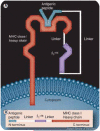Enhancing DNA vaccine potency by modifying the properties of antigen-presenting cells
- PMID: 17408372
- PMCID: PMC3190226
- DOI: 10.1586/14760584.6.2.227
Enhancing DNA vaccine potency by modifying the properties of antigen-presenting cells
Abstract
DNA vaccines represent a potentially promising approach for antigen-specific immunotherapy. Advances in our knowledge of the adaptive immune system have indicated that professional antigen-presenting cells, especially dendritic cells (DCs), play a key role in the generation of antigen-specific immune responses. Thus, the modification of the properties of DCs represents an important strategy for enhancing the potency of DNA vaccines. This review discusses strategies to increase the number of antigen-expressing DCs, enhance antigen expression, processing and presentation in DCs, promote the activation and function of DCs, and improve DC and T-cell interaction, in order to optimize DNA vaccine-elicited immune responses. Continuing progress in our understanding of DC and T-cell biology serves as a foundation for further improvement of DNA vaccine potency, which may lead to future clinical applications of DNA vaccines for the control of infectious diseases and malignancies.
Figures



Similar articles
-
Modifying professional antigen-presenting cells to enhance DNA vaccine potency.Methods Mol Med. 2006;127:199-220. doi: 10.1385/1-59745-168-1:199. Methods Mol Med. 2006. PMID: 16988456 Review.
-
Improving DNA vaccine potency via modification of professional antigen presenting cells.Curr Opin Mol Ther. 2003 Feb;5(1):20-4. Curr Opin Mol Ther. 2003. PMID: 12669466 Review.
-
Dendritic type, accessory cells within the mammalian thymic microenvironment. Antigen presentation in the dendritic neuro-endocrine-immune cellular network.In Vivo. 1997 Jul-Aug;11(4):351-70. In Vivo. 1997. PMID: 9292303
-
In vivo targeting of antigens to human dendritic cells through DC-SIGN elicits stimulatory immune responses and inhibits tumor growth in grafted mouse models.J Immunother. 2007 Oct;30(7):715-26. doi: 10.1097/CJI.0b013e318135472c. J Immunother. 2007. PMID: 17893564
-
Targeting dendritic cells to enhance DNA vaccine potency.Cancer Res. 2001 May 1;61(9):3704-11. Cancer Res. 2001. PMID: 11325842
Cited by
-
Development of a DNA vaccine targeting Merkel cell polyomavirus.Vaccine. 2012 Feb 8;30(7):1322-9. doi: 10.1016/j.vaccine.2011.12.072. Epub 2011 Dec 29. Vaccine. 2012. PMID: 22210138 Free PMC article.
-
Therapeutic human papillomavirus vaccines: current clinical trials and future directions.Expert Opin Biol Ther. 2008 Apr;8(4):421-39. doi: 10.1517/14712598.8.4.421. Expert Opin Biol Ther. 2008. PMID: 18352847 Free PMC article. Review.
-
Treatment with proteasome inhibitor bortezomib enhances antigen-specific CD8+ T-cell-mediated antitumor immunity induced by DNA vaccination.J Mol Med (Berl). 2008 Aug;86(8):899-908. doi: 10.1007/s00109-008-0370-y. Epub 2008 Jun 10. J Mol Med (Berl). 2008. PMID: 18542898 Free PMC article.
-
Prostate cancer as a model for tumour immunotherapy.Nat Rev Immunol. 2010 Aug;10(8):580-93. doi: 10.1038/nri2817. Nat Rev Immunol. 2010. PMID: 20651745 Free PMC article. Review.
-
Improved efficacy of therapeutic HPV DNA vaccine using intramuscular injection with electroporation compared to conventional needle and needle-free jet injector methods.Cell Biosci. 2024 Dec 25;14(1):154. doi: 10.1186/s13578-024-01338-x. Cell Biosci. 2024. PMID: 39722048 Free PMC article.
References
-
- Donnelly JJ, Ulmer JB, Shiver JW, Liu MA. DNA vaccines. Annu Rev Immunol. 1997;15:617–648. - PubMed
-
- Gurunathan S, Klinman DM, Seder RA. DNA vaccines: immunology, application, and optimization. Annu Rev Immunol. 2000;18:927–974. - PubMed
-
- Guermonprez P, Valladeau J, Zitvogel L, Thery C, Amigorena S. Antigen presentation and T cell stimulation by dendritic cells. Annu Rev Immunol. 2002;20:621–667. - PubMed
-
- Steinman RM. The dendritic cell system and its role in immunogenicity. Annu Rev Immunol. 1991;9:271–296. - PubMed
-
- Banchereau J, Briere F, Caux C, et al. Immunobiology of dendritic cells. Annu Rev Immunol. 2000;18:767–811. - PubMed
Publication types
MeSH terms
Substances
Grants and funding
LinkOut - more resources
Full Text Sources
Other Literature Sources
